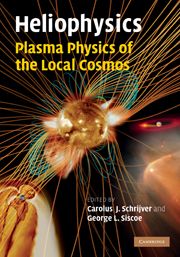Book contents
- Frontmatter
- Contents
- Preface
- 1 Prologue
- 2 Introduction to heliophysics
- 3 Creation and destruction of magnetic field
- 4 Magnetic field topology
- 5 Magnetic reconnection
- 6 Structures of the magnetic field
- 7 Turbulence in space plasmas
- 8 The solar atmosphere
- 9 Stellar winds and magnetic fields
- 10 Fundamentals of planetary magnetospheres
- 11 Solar-wind– magnetosphere coupling: an MHD perspective
- 12 On the ionosphere and chromosphere
- 13 Comparative planetary environments
- Appendix I Authors and editors
- List of illustrations
- List of tables
- References
- Index
11 - Solar-wind– magnetosphere coupling: an MHD perspective
Published online by Cambridge University Press: 05 August 2013
- Frontmatter
- Contents
- Preface
- 1 Prologue
- 2 Introduction to heliophysics
- 3 Creation and destruction of magnetic field
- 4 Magnetic field topology
- 5 Magnetic reconnection
- 6 Structures of the magnetic field
- 7 Turbulence in space plasmas
- 8 The solar atmosphere
- 9 Stellar winds and magnetic fields
- 10 Fundamentals of planetary magnetospheres
- 11 Solar-wind– magnetosphere coupling: an MHD perspective
- 12 On the ionosphere and chromosphere
- 13 Comparative planetary environments
- Appendix I Authors and editors
- List of illustrations
- List of tables
- References
- Index
Summary
Introduction
In Chapter 10 the basic principles that govern magnetospheric structure and dynamics in general were explained. There it was made clear that the magnetosphere is a time-dependent, three-dimensional, multi-component, interacting system. The point of the present chapter is that to obtain a quantitative description of so complex a system, one must resort to numerical models. Moreover, to check the self-consistency of the assumptions behind a conceptual model, one must rely on global numerical simulations. In this chapter we use numerical simulation models that are generally available to illustrate their use in giving global-scale depictions of the structure and dynamics of the terrestrial magnetosphere and we compare the results with our understanding of these subjects developed by other means.
We consider the flow of mass, momentum, energy, and magnetic flux through and around the magnetosphere. These topics involve the macro-scale coupling between the solar wind and the magnetosphere and so are well suited for treatment by global MHD simulations. We start by explaining where numerical models are positioned in the magnetospheric scientist's armory and by briefly describing the illustrative models that we will use.
It comes as no surprise that of the known magnetospheres Earth's is the best observed and understood. What we know about its structure, dynamics, and interaction with the solar wind has been gleaned from decades of ground- and space-based observations, each of which gives us a snapshot of one or more physical processes in the magnetosphere.
- Type
- Chapter
- Information
- Heliophysics: Plasma Physics of the Local Cosmos , pp. 295 - 323Publisher: Cambridge University PressPrint publication year: 2009



